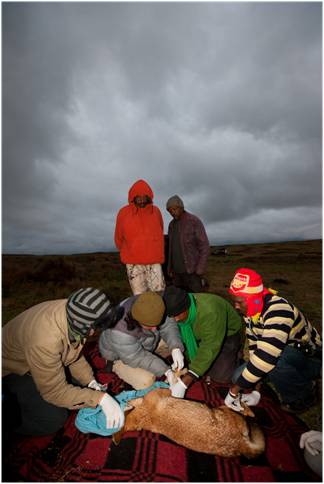

 by Claudio Sillero and Eric Bedin
by Claudio Sillero and Eric Bedin
EWCP intervened quickly to avoid widespread mortality among Ethiopian wolves in Bale, thanks to the early detection of infected wolves. As soon as rabies was confirmed in brain samples from the carcasses found in Sanetti Plateau (by the EPHI and APHA laboratories in Ethiopia and the United Kingdom respectively), an action plan with immediate actions to tackle the outbreak was developed and authorized by the Ethiopian Wolf Conservation Authority (EWCA). The plan followed policy and routine methodologies identified in the Bale Mountains National Park (BMNP) Management Plan and the National Action Plan for Ethiopian Wolf Conservation. The most immediate response was the vaccination of wolves around the infected packs, using 2ml of Merck’s Nobivac Rabies vaccine.
Vaccination started on 11 August 2014 with an Emergency Response Team composed by EWCP staff (capture and logistic teams), EWCA (veterinarian) and BMNP (expert and scouts), under the coordination of Claudio Sillero (EWCP Director), Eric Bedin (EWCP Coordinator) and Fekede Regassa (EWCA Veterinary Officer). After a first wave of infection in the Sanetti Plateau, rabies was confirmed in samples from the Morabawa population, and the vaccination team followed promptly. Wolves were also vaccinated in the Web Valley, to safeguard this important population. For the last vaccination campaign in the Web Valley in early March, EWCA authorized Leta Edea (EWCP vet) to be in charge of the vaccination, recognising the professionalism of the EWCP team.
In total one hundred and six wolves were vaccinated in Bale between August 2014 and March 2015, representing roughly a third of the Bale population. As no pack went extinct as a result of the outbreak, and breeding success was good, the Sanetti population may be already in the way to recover.
We are grateful to WCN and the Born Free Foundation that were able to step in and raise emergency funds for the vaccination operation at very short notice. Additional emergency funding was provided by the Zoological Society of London, the Critical Ecosystem Partnership Fund, Lobelia Press, Zoological Society for the Conservation of Species and Populations (ZGAP), John Stuelpnager, Houston Zoo, Saint Louis Zoo, Jan Richardson, Meryt and Peter Harding, the French Association of Zoo Vets (AFVPZ) Dakota Zoo Conservation Fund, and many others.
We were able to start vaccinating quickly thanks to the generous and efficient support of the logistic teams of Merck MsD Animal Health (Rabivac IM vaccine) and Virbac (SAG2 oral vaccine). All biological samples were analysed by the Ethiopian Public Health Institute in Addis Ababa and the Animal and Plant Health Agency in the UK.